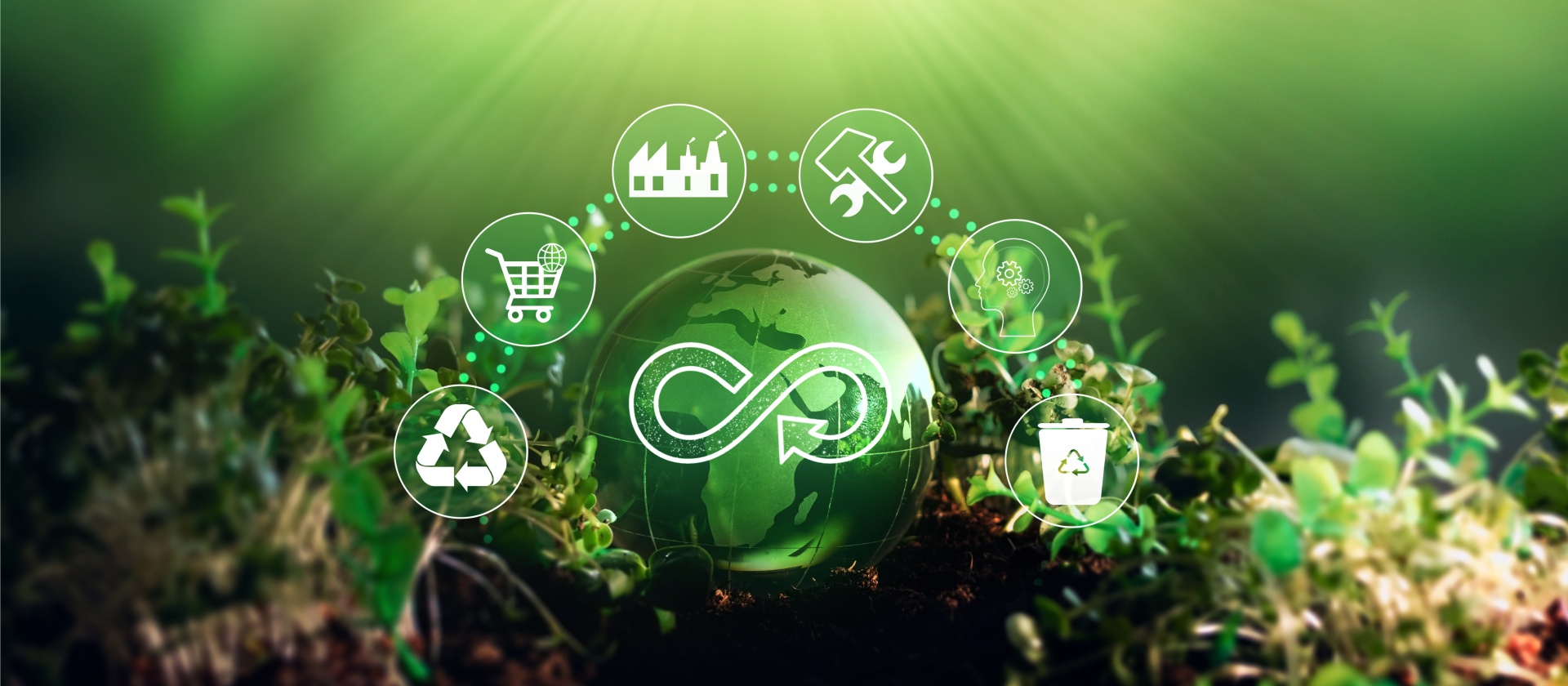Navigating the Green Transition of Fashion with technology
Deda Stealth at the front line to support brands' sustainability strategies
Viktoriia Shiriaeva, Presales Specialist of Deda Stealth
The
principles of the circular economy, from reusing to repairing and
recycling, represent the future of fashion (and beyond) and the most reliable
answer for the next generation's well-being. The circular economy, in
contrast with the linear model, is a system that aims to reduce waste and
trash by reintroducing materials and items back into the production cycle
at the end of their life span. The belief behind this model is that every item
is born to live multiple lives.
Why is it crucial?
The chart
below shows the Overshoot Day i.e., the day of the year when the
consumption of all the resources produced by the planet is determined. This parameter has been recorded from the 1970s till 2023.

For 2023,
the earth overshoot day fell on August 2nd. Meaning
that on that date it is estimated that we ran out of the resources that our
planet can produce in one year, and therefore for the remaining time in 2023 we
would be "borrowing" resources from the following year, basically as
if we had one and a half planets instead of one. Earth overshoot day 2024
hasn't been announced yet, but the trend is disturbing.
Traceability and Transparency: the enablers of a circular economy
The
circular economy fits into this context as one of the possible solutions to
look at, and significant contributions are coming from governments
worldwide, especially in the fashion industry. Starting from January 2022, in
fact, the obligation to collect textile waste separately has been
introduced in Italy, which is a law that will come into effect by 2025 at the
European level as well. These initiatives aim to facilitate the reuse and
recycling of waste to slowly get to the point where waste is reduced to the
bare minimum. Other legislative and regulatory initiatives address the two
enabling factors for the circular economy: transparency and traceability.
Promulgated on 10 February
2020 and entering in force on 1 August of the following year, the AGEC anti-waste law (loi Anti-gaspillage pour une économie circulaire) was created in France with the concrete objective of transforming
the fashion system from a linear economy to a circular economy.
The legislation, which
today counts 130 articles, is based on two fundamental principles:
- The polluter pays;
- More information for the end consumer.
The law therefore seeks to
protect consumers from the 'greenwashing' effect by regulating the use of terms such as
'biodegradable' or 'organic' and encouraging brands to be more transparent
about their production and distribution processes.
The 29 April 2022 decree concerning Article 13
of the AGEC Law provides clear details on the notion of consumer
information on:
1. Traceability of the journey followed by the product during its
manufacturing process;
2. The risks of rejection of plastic microfibers linked
to the use of synthetic materials;
3. The presence of potentially dangerous substances;
4. The presence of recycled materials and the
recyclability of the product.
On the other hand, the
"Kreislaufwirtschaft" (German Circular Economy Act) directive focuses
mainly on separating and recycling industrial and household waste. Finally,
introducing the DPP (Digital Product Passport) will change the
management and retrieval of product information, supporting the principle of
data economy.
The
European Commission wants to accelerate the circular transition, following up
on the goals set by the Green Deal. The DPP will provide information
on the composition of products circulating on the European market, to
increase the possibilities for reuse or recycling.
According
to the new regulation, the product passport will:
1. Ensure
that actors along the value chain, including consumers, can access information
about the product they are interested in.
2. Improve the traceability of products along the value chain.
3. Facilitate
the verification of product compliance by competent authorities.
4. Include
the necessary data attributes to enable traceability of all hazardous
substances throughout the life cycle of the products involved.
The idea is to provide supply chain players with all the data they need to understand better how to properly dispose of any waste or give new life to products. Probably the DPP could finally highlight the many cases of "False Green Claims," better known as Greenwashing cases, helping consumers orient their purchasing choices, and consistently rewarding those production realities that, with so much commitment and determination, try to embrace circularity and sustainability logics.
Deda Stealth's technological solutions to meet the AGEC Law requirements
The already strong synergy and interaction
between sustainability and technology in the fashion industry is transforming
companies in the sector that, supported by technological innovation, can develop
solutions to reduce the environmental impact of the production of clothing,
footwear, and accessories.
A merge that opens up new perspectives for a fashion industry that is more ethical,
transparent, and respectful of the planet and people. This is a commitment that Deda
Stealth has been accepting and pursuing for several years, demonstrating a
concrete desire to contribute to the creation of more transparent processes and
ethical fashion.
Deda Stealth's innovative technological
solutions ensure that fashion and luxury brands can adapt their business to
current regulations on environmental sustainability and supply chain
traceability.
According to the AGEC Law, fashion brands that want to distribute
and sell their products in France are required to make available to the
consumer data such as the path followed by the product during its manufacture,
the percentage of non-organic fibers used in production, the use of chemicals
or recycled materials.

Gathering all this data on
a value chain as complex as the fashion one is the challenge taken up by Deda
Stealth, which with the Stealth® Platform solution from
2023 permits the calculation:
1. For the Apparel sector:
- The percentage of recycled materials on the weight of the finished
product;
- The recyclability of materials used in production;
- Presence of pollutants;
- Supplier and country of origin indication for Packaging, Dyeing,
Printing, Weaving;
- Percentage of microplastics in the total weight of the finished product.
2. For the footwear sector:
- The percentage of recycled materials on the weight of the finished
product;
- The recyclability of materials used in production;
- Presence of pollutants;
- Indication of Supplier and Country of Origin for Finishing, Assembly,
Stapling;
- Percentage of microplastics in the total weight of the finished product.
Circularity at risk
The circular
economy can only be part of the long-term solution, but attention must be
paid to the fact that even if this approach is taking future waste into
account, it does not prevent it. The volume of textile waste is huge, although
consumers often struggle to perceive it.
Donations of clothing made in the
global south, usually do not get to be reused for 3 main reasons:
1. They are
not useful clothes in that particular region of the world;
2. The
quality of the clothes is low and does not allow reuse;
3. They are
too many compared to the demand.
Most
textiles used today are not of natural origin. Therefore, they alone can never
be disposed of in the environment. At the same time, however, if recycled at
the end of its life, it requires the least consumption of resources (compared
to production from scratch). In addition, we must always take into account the
complexity behind an "organic" production approach, because the
cultivation of cotton, a natural fiber, requires very high-water consumption
and uses a lot of land. So, while being natural, it does not guarantee zero
impact. Furthermore, another aspect concerns synthetic fibers: nowadays, there
is no full knowledge of any technique for recycling them, nor for making these
fabrics less harmful to the environment (e.g., depolymerization that prevents
the release of microplastics).
Whether it
is because of high costs, or the difficulty of sourcing low-impact raw
materials, circularity is not always easy to implement. Moreover,
focusing exclusively on the end-of-life of garments is not enough, because circularity
requires a holistic approach that starts upstream in the value chain, that
is, to make the product have a second life, and already at the design
stage it is necessary to consider this aspect. A product itself can never
be called "sustainable" if it is created following a business model
that is not. The increase in circularity cannot be directly proportional to the
increase in production, but on the contrary, it must make up for the excessive
use of the available resources, and at the same time it cannot be an excuse to
continue producing as before ("we recycle it later anyway").
The urgency
of transformation is, by now, clear. The industry needs an evolution of
procurement processes and, not least, internal processes as well. We are
certainly talking about a complicated and ambitious challenge, but with the
support of technological development and digitalization, companies can apply
less resource-consuming production models and incorporate traceability and
transparency practices to their supply chains.
For
additional insights on the topic, we recommend the webinar "Digital
Product Passport, Incoming Legislation and the effects on Fashion Supply
Chain" (available here).








